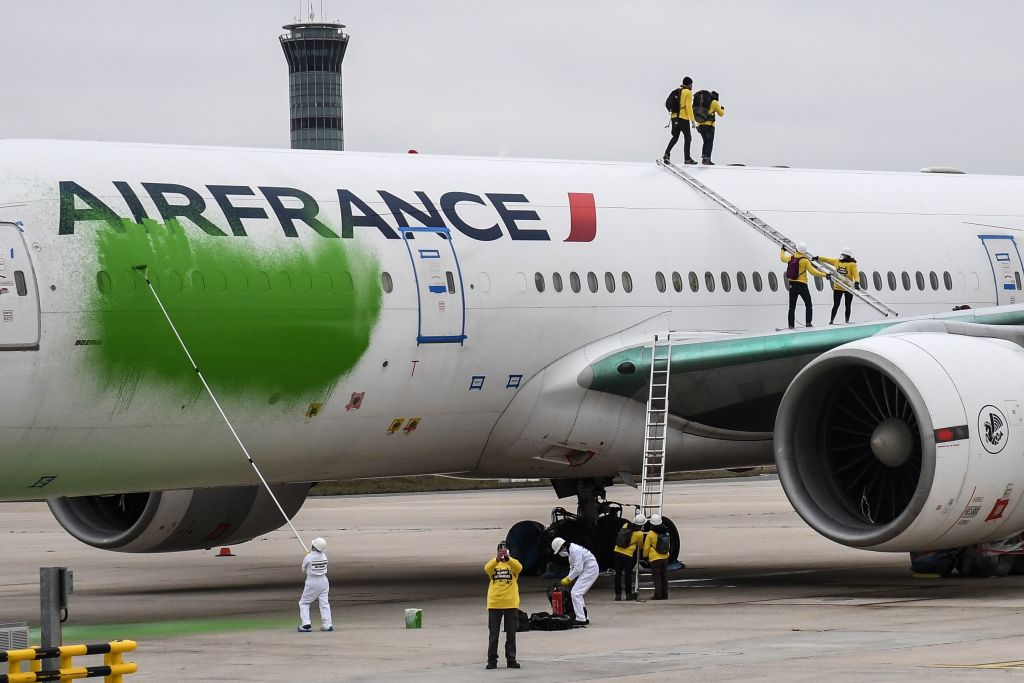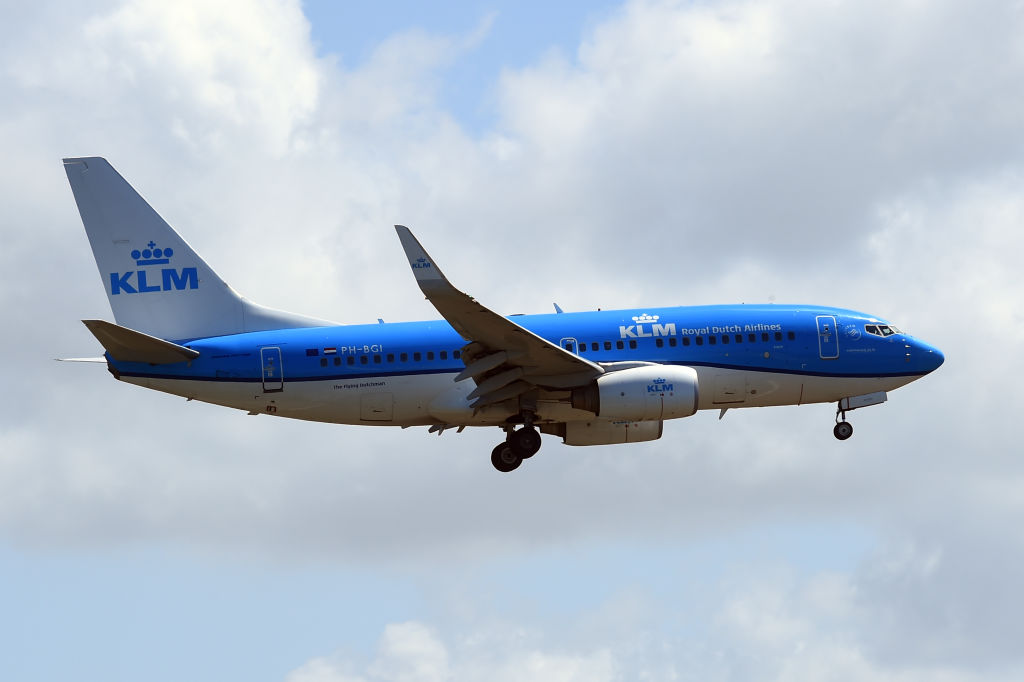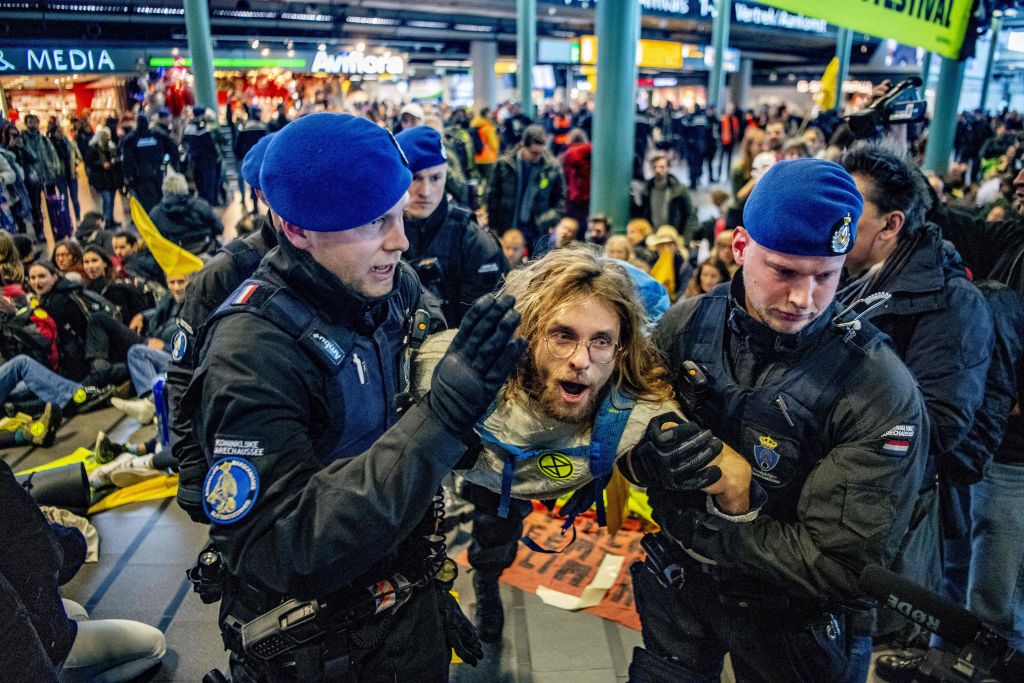
Travel restrictions imposed across the world during the COVID-19 pandemic forced airlines to plead for government bailouts and lay off staff, while some folded entirely. There was one silver lining, though: a huge temporary drop in the sector’s carbon emissions. Now, as lockdowns begin to ease, and travellers book their first post-pandemic trips, aviation faces a stark challenge: is it possible for airlines to revive their businesses while lowering their emissions long term?
In 2019, carbon dioxide emissions from aviation made up 2.5% of global emissions of the greenhouse gas. The plunge in traffic last year meant that, after decades of almost uninterrupted rapid growth, the sector’s carbon emissions fell by a record 48%, according to Carbon Monitor, an international watchdog. But as people return to pre-pandemic activities, driving up demand for energy globally, those emissions will start to rebound. Airline executives in the U.S. and other parts of the world with high vaccination rates are expecting a sharp uptick in air travel this year, bolstered by the news that the European Union plans to allow vaccinated tourists to visit this summer.
Aviation is considered one of the hardest sectors of the global economy to decarbonize, because the fuels and technology needed to fly without emitting greenhouse gases are much less well-developed than clean energy sources in sectors such as electricity or road transport. As other sectors reduce their emissions, aviation is expected to make up an increasingly large share of the world’s total.
While the pandemic’s impact on aviation will likely help bring down the industry’s emissions, it’s far from enough to meet long-term climate goals. Before COVID-19 hit, the sector’s carbon emissions were expected to be three times greater in 2050 than in 2015. Dan Rutherford, aviation director at the International Council on Clean Transportation (ICCT), a non-profit research group, thinks the increase will now be closer to 2.3 times. “So it’s still growing, just at a slower rate.”
Public and government pressure on airlines to do more to reduce emissions is ramping up. As some airlines became reliant on public bailouts during the pandemic, governments in Europe hardened their approach to aviation emissions. Austria made its rescue funds for Lufthansa’s Austrian Airlines unit dependent on the carrier cutting back domestic routes and agreeing to new emissions and fuel efficiency targets. France outlawed some short-haul domestic flights where rail alternatives are available, while the U.K. became the first major economy to include aviation emissions in its national carbon budget, setting what campaigners call an important precedent. Meanwhile, responding to pressure from politicians and the public, airlines have set themselves increasingly ambitious climate targets, with dozens pledging to reach net zero carbon emissions by 2050 in recent months, compared to previous industry-wide plans to halve emissions by 2050.
“Before the pandemic, the sector was quite arrogant in feeling that it didn’t need to make the same sort of cuts and transformations that other sectors were doing,” says Andrew Murphy, aviation director at European clean transit campaign group Transport & Environment. “Now the politics has changed.”
Airlines’ climate plans still rely heavily on carbon off-setting, where they essentially pay other sectors to reduce their emissions or absorb carbon from the atmosphere. A May 3 Greenpeace-led investigation found offsetting schemes still used by major airlines are highly flawed and may not be having the desired impact.

Sustainable fuel future?
The industry’s preferred path out of its emissions bind is sustainable aviation fuel (SAF). Currently fuelling a tiny fraction of flights, SAF could cut aviation emissions by up to 80% if used more widely, according to the Air Transport Action Group, a trade association. It has been the focus of a flurry of lobbying activity, investment and discussions among policymakers as governments roll out COVID-19 recovery packages and climate plans. In the U.S., Congress is considering plans put forward by the Biden administration to introduce a tax credit for SAF production.
Sustainable aviation fuels are made from a range of sources, including used cooking oil, animal fats, plant oils and waste vegetation, as well as wood. They have to meet certain criteria to be considered sustainable, and environmentalists have warned that, without strong oversight, production of these fuels could encourage deforestation because producers may end up clearing land to grow materials to produce the feedstocks. Cleaner “e-fuels”—synthetic alternatives to crude oil produced using renewable energy, water and carbon dioxide—are also in development and one was used to power a test flight for the first time worldwide in the Netherlands in February.
Oil companies, including Shell and BP, have invested in SAF, partnering with renewable energy firms and biofuel companies to create small supply chains. Currently, SAF costs between three and four times more than traditional kerosene fuel, while e-fuels can be between six and seven times more expensive than kerosene.
Over the last five years, SAF made up just 0.01% of total fuel use by the aviation industry, according to the International Energy Agency. But several airlines have announced plans to increase their use of SAF in recent weeks. In April, United Airlines announced a deal with a dozen companies to finance its use of 3.4 million gallons of SAF made from trash in 2021, tripling the amount it has used in each of the last five years. British Airways-owner International Airlines Group has committed to using sustainable aviation fuel to power 10% of its flights by 2030, while European carrier Ryanair has pledged to use SAF for 12.5% of its fuel needs by 2030. Meanwhile, the E.U. is expected to announce a mandate for a small proportion of fuel used in flights departing from airports in the bloc to be sustainable by 2030.
Supply chains would need to develop rapidly to meet those targets. A World Economic Forum report published in November found that, although enough sustainable feedstocks exist to power the entire industry on SAF, the production plants currently planned worldwide would only have capacity to produce 4 million tons annually each year, around 1% of projected fuel demand.
Airlines and oil companies argue that governments need to offer subsidies, tax breaks and other incentives to allow them to develop SAF quickly enough to meet emissions goals. Michael Gill, environment director of industry trade body the International Air Transport Association (IATA), says that investing in SAF is a “win-win-win” option for governments during the economic recovery from COVID-19. “You can create new jobs, you can have the construction of new facilities in geographical areas that need that kind of large scale infrastructure. And you can help aviation build a sustainable future,“ he says. IATA is also calling for research and development of more radical new zero-emissions aircraft technology, such as planes powered by hydrogen, which experts hope will eventually be used in most short-haul flights.
Some climate activists may be uncomfortable with the aviation sector or oil companies, both massive polluters, receiving public funds and tax breaks to develop the technologies that they need to protect their bottom lines in a future of increased climate regulation. Murphy, of Transport & Environment, says it’s reasonable for any sector that needs to decarbonize to ask for government support, given the urgency of scaling up new technologies. “But it can’t just be about handing out money for research and development and doing test drives,” he says. “The money needs to be accompanied with binding targets [on SAF use and emissions.]”

Emboldened governments
Before the pandemic, the aviation industry had argued that the sector was too international to be regulated by individual countries. The most important piece of emissions regulation for the sector was an international agreement to offset future increases on the sector’s 2020 emissions, criticized by climate campaigners as too weak to have an impact.
Bailouts have changed the dynamic for regulation, Murphy says. “We’re seeing airlines now recognize that if it was not for the efforts of national governments and the generosity of taxpayers, the sector would have gone bankrupt. That has caused a re-evaluation of what they can expect to get away with.”
Consultancy McKinsey says the “staggering” debt levels built up by airlines over the last year mean states that bail out airlines will have an increasingly active role in the sector, creating opportunities for governments to work with airlines, including on commitments to cut emissions. E.U. leaders are considering scrapping a tax exemption on jet fuel for international flights, which exists partly because of the difficulty of coordinating taxes between national governments, but has attracted increasing criticism as the bloc emerges as a climate leader.
On the flip side, it’s also possible that increased state ownership of airlines will make governments impatient to return them to profitability, and therefore less willing to impose new taxes or restrictions that could hit airlines’ bottom line. After France’s citizens assembly on climate proposed a new environmental tax on flights in September, some lawmakers argued it didn’t make sense to raise taxes on airlines that the state was propping up and the plans were shelved. The U.K. government is weighing plans to eliminate a roughly $18 duty it imposes on domestic flights to offer some relief for airlines. IATA opposes any tax increases on aviation during the COVID-19 recovery.
Shifting behavior
Flying is likely to remain one of the most carbon-intensive activities humans can participate in for years to come, and avoiding flights is one of the most effective ways for people in rich countries to reduce their emissions. A return flight from San Francisco to London emits the equivalent of around 5.5 metric tons of CO2 per person—more than the world’s annual average per person emissions in 2019 (4.8 metric tons). It is also a luxury enjoyed by a privileged few. Just 11% of the global population took a flight in 2018 and 1% of the population was responsible for 50% of aviation emissions, according to a study led by Sweden’s Linnaeus University in November. Climate activists, including many scientists, say a rapid and massive reduction in air travel is the only safe path to avoid catastrophic climate change.
Individual responsibility will likely play a role in the drive to cut emissions. Since before the pandemic, the “flight shame” movement, popularized by Swedish climate activist Greta Thunberg, had already begun to have a “real impact” on demand for short-haul air travel in Europe, Rutherford says. “That big change in attitudes that started in 2019, has not gone away and we’re going to see those political pressures build as the industry recovers from COVID.”
Some governments and trade groups are trying to encourage a shift toward rail travel for shorter journeys. While the French and Austrian governments have made efforts to curtail short-haul air travel, the German Aviation Association is collaborating with rail company Deutsche Bahn to replace domestic flight routes with train services in Germany. Governments in countries including Italy and Belgium are investing heavily in their train networks as part of recovery plans to help pull them out of the economic crisis brought about by the pandemic.
For the U.S., a pivot from shorter flights to train travel will be more challenging. The country covers an area twice the size of the E.U., and many stretches of its rail network suffer from decades of under investment. In a recent interview with TIME, William Flynn, the CEO of passenger rail service Amtrak, said he would use $80 billion in federal funds proposed in President Biden’s infrastructure plan to overhaul and improve key routes. But far more is likely needed to improve service enough to make trains an attractive replacement for flights, Rutherford says. Some U.S. airlines are beginning to voluntarily coordinate better with rail networks to phase out some unnecessary short-haul routes, but it’s still on a “case by case basis,” he adds.
Although curbs on short-haul flights will have some impact, according to ICCT data, more than two thirds of aviation’s emissions come from medium- or long-haul flights, where train and road travel are not realistic alternatives. Forcing airlines to limit the services they provide on these routes is less palatable for governments than short-haul restrictions.
But behavioural changes triggered by the pandemic may have a dramatic impact on the long-haul business. Companies are reassessing the value of business travel after a year of conducting meetings using video conferencing services like Zoom. Only a third of business travelers in the U.K. expect to return to their pre-pandemic habits, according to an April poll. Microsoft co-founder Bill Gates predicts that more than 50% of business travel will disappear. McKinsey is more conservative, estimating in April that business travel will recover to around 80% of pre-pandemic levels by 2024.
Business travelers, who tend to book late and often choose premium seats, generate the bulk of the profits on long-haul flights. This type of travel accounts for up to 75% of airlines’ revenues on some routes. To make up for the loss, McKinsey says, airlines may reduce the frequency of flights, raise prices for leisure travelers and close the gap in prices for direct and connecting flights. All of those measures would likely have the unintentional benefit of helping to reduce emissions.
Gill, IATA’s environment director, acknowledges that many people who are considering booking a flight when travel restrictions lift “will be asking themselves that question: from an environmental perspective, is this responsible? We need to answer that question as an industry.”
More Must-Reads From TIME
- Dua Lipa Manifested All of This
- Exclusive: Google Workers Revolt Over $1.2 Billion Contract With Israel
- Stop Looking for Your Forever Home
- The Sympathizer Counters 50 Years of Hollywood Vietnam War Narratives
- The Bliss of Seeing the Eclipse From Cleveland
- Hormonal Birth Control Doesn’t Deserve Its Bad Reputation
- The Best TV Shows to Watch on Peacock
- Want Weekly Recs on What to Watch, Read, and More? Sign Up for Worth Your Time
Write to Ciara Nugent at ciara.nugent@time.com